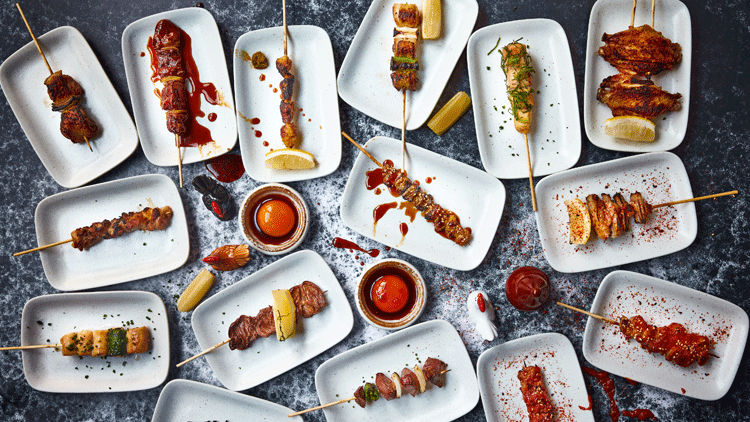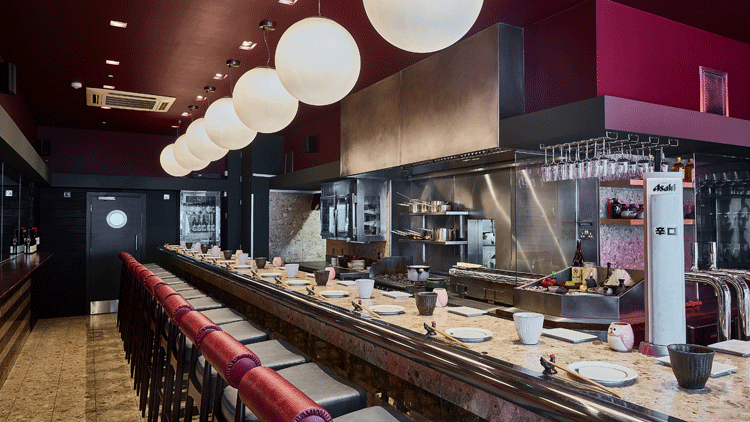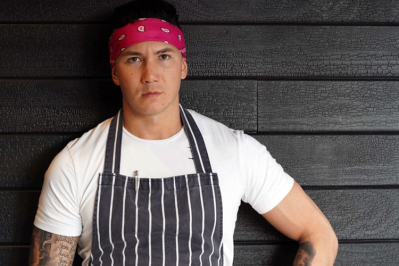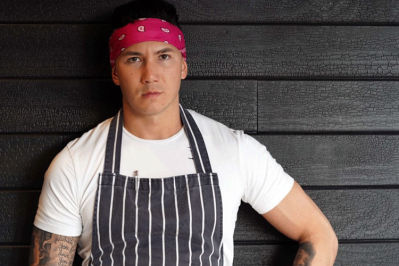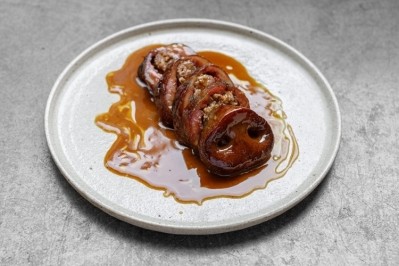Chick magnate: Angelo Sato on the art of yakitori
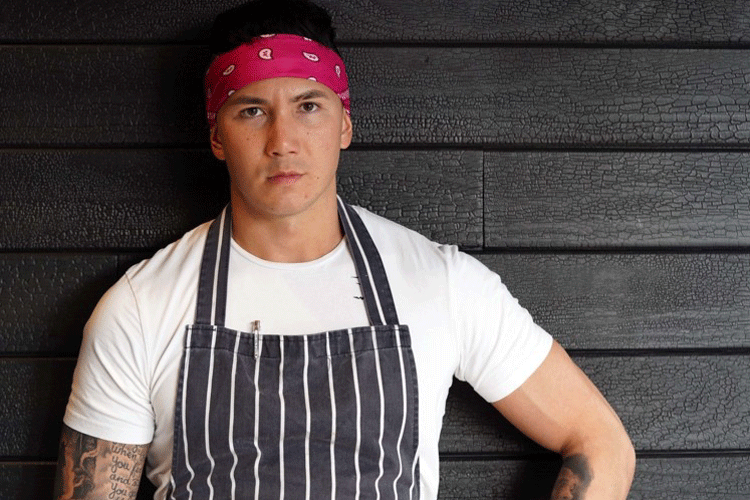
Angelo Sato's knife dances back and forth as he scrapes the subcutaneous fat from a flap of chicken skin and deftly wraps it around the soriresu – the oyster – that he has just separated from the bird’s leg.
“It’s important to get all the fat off the skin because it won’t render out when you get it on the grill – it will be chewy,” he councils, before quickly moving onto the thigh meat. This is treated in a similar way to the oyster, with the fat partly wound round each bitesize morsel of meat to shield it from the blistering heat of the grill.
“You can tell you’re in a yakitori place that’s doing things properly when one side of the thigh meat is completely covered by the skin. That makes for really juicy meat.”
Born in Japan, Sato is a chef that knows his bonjiri (parson’s nose) from his furisode (shoulder – yes, chickens have shoulders) having worked casually at several yakitori joints as a teenager and – more recently – spent six months honing his technique at a more high-reaching yakitori restaurant in Fukuoka.
The art of grilling small skewers of chicken meat and offal over charcoal – yakitori means ‘grilled bird’ - has been perfected by the Japanese since the late 18th century. There are thousands of specialist yakitori places in Japan, ranging from street stalls and basic, pub-like izakayas to slick, high-end restaurants run by gastronomically ambitious chefs.
Opened earlier this year, Soho’s Humble Chicken sees the 29-year-old combine this very specific experience with stints at some of the world’s most decorated restaurants, including Narisawa and RyuGin in Tokyo, Eleven Madison Park in New York, and Restaurant Gordon Ramsay and Restaurant Story in London (he was head chef at the latter). Since striking out on his own, Sato has launched two casual takeaway and delivery orientated concepts – katsu sando brand Yatai and sushi bowl specialist Omoide – but this is his first restaurant proper.
The Firth Street site has been well-received, chalking up glowing reviews from Observer critic Jay Rayner and The Times critic Giles Coren. Proper yakitori is rare in the UK: there are only a handful of specialists including Brighton’s Bincho Yakitori and London’s Jin Kinchi and the recently launched Junsei (it should also be noted that while Rainer Becker’s Roka, Zuma and Inko Nito aren’t yakitori specialists, they are pioneers of Japanese grilling on these shores).
A bird in the hand
Sato is busy prepping the 20 or so birds needed for service this evening. Each takes three to four minutes to breakdown. That might not sound that fast, but Sato is creating about 15 different cuts per bird and some of them are fiddly. He cuts and pulls the chicken apart with astonishing dexterity, creating neat little portions of meat that will later be skewered by less experienced members of his team (only he and brother John Paul, who also worked in yakitori restaurants in Fukuoka, are currently butchering the birds).
“For good yakitori you need to find the muscles and joints. When you do, you can usually just pull. You don’t ever want to be cutting through individual muscles as this will cause it to bleed out onto the grill as it cooks, becoming dry,” says Sato, who sources his chickens from Suffolk’s Sutton Hoo, a top-end producer favoured by some of London’s best restaurants including Daniel Humm’s Davies and Brook.
“Delicious fat is key for yakitori so you need some age, but you don’t want something that’s been running around for a long time as it will be too tough,” he explains. “That means a lot of high-quality chickens aren’t right for yakitori. There is obviously a huge market for yakitori in Japan so there are lots of great producers rearing birds specifically for that purpose. But Sutton Hoo is great, the birds are beautiful.”
Offal is trickier on these shores as chefs tend to be less interested it. While the birds are supplied with some of their innards, Sato has had his work cut out securing the less obvious parts of his birds including gizzards and necks as the supply chain is not set up for it.
Making ends meet
At £6.50 per kilo, each chicken is costing Sato a little under £20. The small skewers average out at £3.50, an excellent food margin, but one that needs to be weighed up against unusually high labour costs. Margins are further boosted by their being virtually no wastage. The trim and fat are used for tsukune (chicken meatballs) and the bones used for stock, which is used in some of Humble Chicken’s small selection of non-yakitori plates.
As a rule, the rarest parts of the bird are the most prized in Japan and tend to be priced at a premium when compared to more plentiful cuts. Sato – who has opted to use largely western words to describe the cuts on the menu - has been cheered by his customer’s willingness to explore unfamiliar bits of chicken that often contain cartilage, collagen, and fat deposits.
“Like yakitori places in Japan, we sell out of certain cuts as the evening goes on,” he says. “There are some skewers you need more than one chicken for, including the parson’s nose, the belly meat and skin, so these tend to sell out first.”
Humble Chicken struggles to get through the breast meat, which is ironic given that it is usually considered the most premium part of the bird (he jokes that he should investigate selling them to other restaurants).
You'd be forgiven for thinking that Sato uses a rarefied Japanese-made knife to breakdown his chickens, but his blade of choice is a £20 Victorinox boning knife. "You can sharpen them constantly as you work but most importantly the handle does not get slippery when it gets covered in fat,” he explains.
A largely traditional approach
The skewers are typically loaded with three to four bitesize pieces of meat with the largest piece the last onto the skewer for reasons of both aesthetics and practicality (the rear of the grill is hottest). Skewering the meat is a more skilled job than one might think, with chefs often having to work the point of the skewer through specific muscles and sections of the bird to avoid damaging the meat.
Cooking technique varies according to the cut. Skin can handle more heat than flesh so skewers are typically cooked mainly on the skin side before being quickly finished on the other side. Chicken wings are cooked bone-in in such a way that the customer can easily pull the bones out and some cuts are cooked over burning pieces of chicken fat to impart an extra smoky flavour. Binchotan – AKA Japanese white charcoal - is essential for proper yakitori due to its high heat output and lengthy burn time.
Portable Konro grills - which are comparable in function to the built-in grills used in specialist yakitori restaurants - have become popular in top-end UK restaurants over the past few years. But Sato - who moved to the UK from Japan when he was 17 – is of the opinion that many restaurants aren’t using them correctly. “There are a lot of posh restaurants, I’m talking two and three stars, that don’t understand the technique,” he says.
Each skewer has its own flavourings, with some brushed on during cooking and some added once it has left the grill. As a rule, the gutsier the cut the more flavourful the accompaniment. For example, Humble Chicken’s mixed offal skewer is flavoured with tare – a powerfully-flavoured liquor made with soy sauce, sake and mirin – and sansho pepper, while breast is partnered with Japanese plum and shiso.
Sato says his approach to yakitori is respectful but would probably not be considered traditional in Japan. “In Japan flavours tend to be very simple, often nothing more than salt and pepper. We don’t use sauces, which would be considered very inauthentic, but we do use ferments and flavoured oils. For example, we use a chicken fat and burnt scallion oil to finish our achilles skewer.
"We’re just trying to intensify the flavour. We’re not trying to do anything fancy. At the end of the day when you eat food you just want it to be fucking yummy.”
